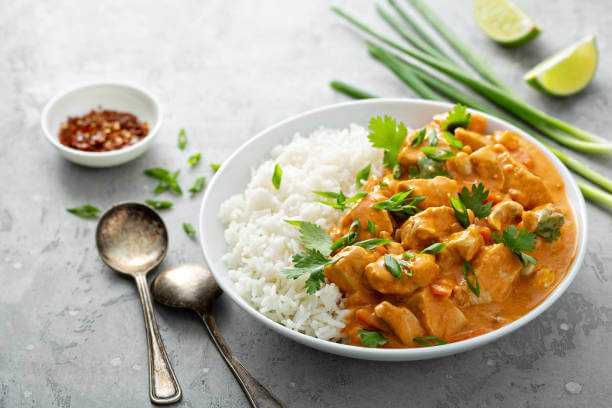
Basmati rice, known for its long grains and distinct aroma, originates from the Indian subcontinent. It is primarily cultivated in the fertile alluvial plains of the Himalayan region, where the unique climate and soil contribute to its exceptional quality. Basmati rice is characterised by its delicate, nutty flavour and fluffy texture when cooked. It is favoured for its non-sticky nature, making it an ideal choice for biryani, pilaf, and other rice-based dishes.
The popularity of Basmati rice has spread globally, with its usage extending beyond traditional Indian cuisine. Its versatile nature allows it to complement a wide range of savoury and sweet dishes, making it a staple in kitchens worldwide. Whether it’s used in classic dishes like Spanish paella or paired with exotic spices in Middle Eastern cuisine, Basmati rice adds a fragrant and flavourful touch to any recipe.
Its ability to absorb flavours and aromas makes it a favourite choice for dishes such as stir-fries, risottos, and even desserts. The long, slender grains remain separate when cooked, providing an elegant presentation in any dish. Basmati rice has become an essential ingredient in fusion dishes, blending seamlessly with ingredients from different culinary traditions.
With its rich history, unique characteristics, and global appeal, Basmati rice continues to captivate the taste buds of food enthusiasts around the world. Whether it’s a traditional Indian meal or a modern fusion creation, Basmati rice adds a touch of sophistication and flavour to every dish it graces.

The Story Behind Basmati Rice
Basmati rice, often referred to as the “king of rice,” has a fascinating history that dates back centuries. This unique variety of rice is primarily grown in the Indian subcontinent, particularly in the foothills of the Himalayas. The word “Basmati” is derived from the Sanskrit word “vasmati,” meaning “fragrant,” which perfectly encapsulates one of its most distinctive features.
What sets Basmati rice apart is its exceptional aroma, long and slender grains, and distinct flavour profile. When cooked, the rice emanates a captivating fragrance that is often described as nutty or popcorn-like, adding an aromatic dimension to any dish. The elongated grains remain separate and fluffy, making it a popular choice for biryani, pilaf, and other rice-based dishes.
The unique flavour of Basmati rice is often described as delicate and nutty, with a subtle earthiness that complements a wide range of cuisines. Its ability to absorb the flavours of spices and other ingredients makes it a versatile staple in various culinary traditions, from Indian and Pakistani cuisines to Middle Eastern and Persian dishes.
In recent years, Basmati rice has gained popularity worldwide due to its exquisite taste and texture, and it has become a sought-after ingredient in diverse international cuisines. Its rich history and exceptional qualities have solidified its reputation as a premium and beloved variety of rice, cherished for its alluring aroma, long grains, and distinct flavour profile.

Cooking African Basmati Rice Perfectly
Alright, here’s the lowdown on cooking the perfect Basmati rice.
Step 1: Rinse your rice
Before you start cooking, rinse your Basmati rice under cold water until the water runs clear. This helps remove excess starch and prevents the rice from becoming too sticky.
Step 2: Soak the rice (optional)
Soaking the rice for 30 minutes to an hour before cooking can help the grains cook more evenly and become fluffier. If you have the time, give it a soak!
Step 3: Measure the water
For every cup of Basmati rice, use 1 ¾ cups of water. This ratio usually works well, but you can adjust it slightly according to your preference for softer or firmer rice.
Step 4: Boil the water
Bring the water to a boil in a medium-sized pot. Add a pinch of salt to enhance the flavour of the rice.
Step 5: Add the rice
Once the water is boiling, add the rinsed and drained rice to the pot. Stir it once to make sure the grains are submerged in the water.
Step 6: Cook the rice
Reduce the heat to low, cover the pot with a tight-fitting lid, and let the rice simmer for about 15-20 minutes. Avoid peeking or stirring the rice during this time, as it can disrupt the cooking process.
Step 7: Let it rest
Once the rice is cooked, remove the pot from the heat and let it sit, covered, for another 5-10 minutes. This allows the steam to further cook the rice and gives it a chance to firm up.
Tips for enhancing the aroma and texture of Basmati rice
- You can add whole spices like cinnamon sticks, cardamom pods, or cloves to the water before adding the rice to infuse it with extra fragrance.
- For an extra fluffy texture, add a teaspoon of oil or ghee to the water before adding the rice.
- Consider adding a splash of coconut milk or a few saffron threads to the water for a richer flavour and aroma.

Basmati Rice Recipes from Around the World
Here are some diverse Basmati rice recipes from various cultures to add a flavourful twist to your meals.
Chicken Biryani
This classic Indian dish is a flavourful mix of basmati rice, tender chicken, and aromatic spices. To make it, marinate chicken pieces in yoghurt and spices, then layer it with parboiled basmati rice, and cook it all together with saffron-infused milk. Garnish with fried onions, nuts, and fresh cilantro for a delicious and fragrant meal.
Vegetable Pilaf
Pilaf is a versatile rice dish that can be found in various cultures. For a vegetable pilaf, sauté onions, carrots, and bell peppers in a pot, then add basmati rice, vegetable broth, and a blend of spices like cumin, coriander, and cinnamon. Let it simmer until the rice is fluffy and infused with flavour.
Thai Coconut Rice
This creamy and fragrant rice dish is a staple in Thai cuisine. To make it, simmer basmati rice in a mixture of coconut milk and water, with a touch of sugar and salt. Once the rice is cooked, fluff it up and serve it as a side dish with your favorite Thai curries or grilled meats.
Saffron Rice
In Persian cuisine, saffron rice is a beloved delicacy. Soak a pinch of saffron threads in warm water, then mix it with cooked basmati rice, and let it rest for the saffron to infuse its aroma and color. Garnish with lightly toasted slivered almonds and pistachios for a luxurious and aromatic side dish.
Mediterranean Rice Salad
For a refreshing and vibrant dish, mix cooked and cooled basmati rice with chopped cucumbers, tomatoes, bell peppers, and a handful of fresh herbs like mint and parsley. Toss it all with a simple vinaigrette and crumbled feta cheese for a delightful Mediterranean-inspired rice salad.

Fusion and Innovative Basmati Rice Recipes
When it comes to contemporary and fusion recipes, Basmati rice is a versatile ingredient that can be used in so many exciting ways. How about trying a delicious Basmati rice salad with a zesty lemon vinaigrette and a mix of fresh herbs and veggies? It’s a refreshing take on the traditional rice salad that’s perfect for a light and refreshing meal.
Or, if you’re feeling adventurous, why not explore the fusion of flavours by making a spicy Basmati rice sushi roll? Fill it with your favourite ingredients like avocado, mango, and even some crunchy tempura veggies for an unexpected twist on a classic dish.
For a cosy and comforting option, you can also experiment with a creamy coconut Basmati rice pudding, infused with cardamom and topped with a caramelised mango compote. This dessert brings a modern touch to a beloved classic.

Health Benefits of Basmati Rice
Basmati rice is not only famous for its delightful aroma and long, slender grains but also for its nutritional benefits. Compared to other rice varieties, Basmati rice offers several advantages that make it a healthy choice for your diet.
One of the key nutritional benefits of Basmati rice is its low glycemic index. This means that it is digested and absorbed more slowly, leading to a gradual rise in blood sugar levels compared to high-glycemic index foods. As a result, Basmati rice can help in controlling blood sugar levels and is often recommended for people with diabetes or those looking to manage their weight.
Moreover, Basmati rice is also gluten-free, making it an excellent option for individuals with gluten sensitivities or celiac disease. It provides a safe and delicious alternative for those who need to avoid gluten in their diet.
In addition to these health advantages, Basmati rice is a good source of energy-boosting carbohydrates and contains essential nutrients such as vitamins and minerals. It is also low in fat and sodium, making it a heart-healthy choice for your meals.

Conclusion
Basmati rice is a long-grain rice known for its delicate flavour, enticing aroma, and versatility in cooking. It has a rich history dating back centuries in the Indian subcontinent, where it was cultivated and treasured as a royal delicacy. With its slender grains and fluffy texture when cooked, Basmati rice has become a staple in many cuisines around the world, particularly in Indian, Middle Eastern, and Persian dishes.
The culinary significance of Basmati rice lies in its ability to complement a wide range of flavours and ingredients. It serves as a perfect base for pilafs, biryanis, and other rice-based dishes, absorbing the spices and aromatics while maintaining its distinct fragrance. Basmati rice can also be used in a variety of dishes beyond traditional recipes, such as rice salads, stir-fries, and even desserts like rice pudding.
If you will like to flex your culinary muscles with basmati rice recipes, you should check out our range of basmati rice. At Niyis, we’ve got you covered on all things grocery, personal care and household. Shop with us today.





Leave a comment